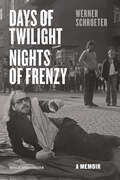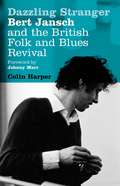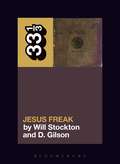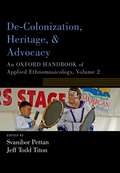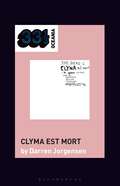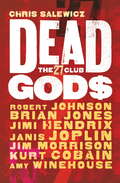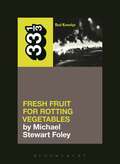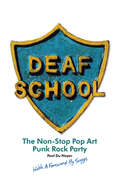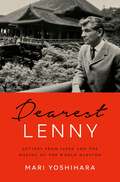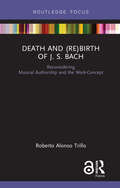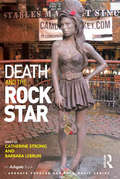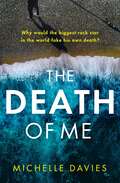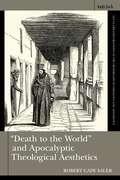- Table View
- List View
Days of Twilight, Nights of Frenzy: A Memoir
by Werner Schroeter Claudia LenssenWerner Schroeter was a leading figure of New German Cinema. In more than forty films made between 1967 and 2008, including features, documentaries, and shorts, he ignored conventional narrative, creating instead dense, evocative collages of image and sound. For years, his work was eclipsed by contemporaries such as Wim Wenders, Rainer Werner Fassbinder, Werner Herzog, and Alexander Kluge. Yet his work has become known to a wider audience through several recent retrospectives, including at the Museum of Modern Art, New York. Written in the last years of his life, Days of Twilight, Nights of Frenzy sees Schroeter looking back at his life with the help of film critic and friend Claudia Lenssen. Born in 1945, Schroeter grew up near Heidelberg and spent just a few weeks in film school before leaving to create his earliest works. Over the years, he would work with acclaimed artists, including Marianne Hopps, Isabelle Huppert, Candy Darling, and Christine Kaufmann. In the 1970s, Schroeter also embarked on prolific parallel careers in theater and opera, where he worked in close collaboration with the legendary diva Maria Callas. His childhood; his travels in Italy, France, and Latin America; his coming out and subsequent life as an gay man in Europe; and his run-ins with Hollywood are but a few of the subjects Schroeter recalls with insights and characteristic understated humor. A sharp, lively, even funny memoir, Days of Twilight, Nights of Frenzy captures Schroeter’s extravagant life vividly over a vast prolific career, including many stories that might have been lost were it not for this book. It is sure to fascinate cinephiles and anyone interested in the culture around film and the arts.
Days of Twilight, Nights of Frenzy: A Memoir
by Werner Schroeter Claudia LenssenWerner Schroeter was a leading figure of New German Cinema. In more than forty films made between 1967 and 2008, including features, documentaries, and shorts, he ignored conventional narrative, creating instead dense, evocative collages of image and sound. For years, his work was eclipsed by contemporaries such as Wim Wenders, Rainer Werner Fassbinder, Werner Herzog, and Alexander Kluge. Yet his work has become known to a wider audience through several recent retrospectives, including at the Museum of Modern Art, New York. Written in the last years of his life, Days of Twilight, Nights of Frenzy sees Schroeter looking back at his life with the help of film critic and friend Claudia Lenssen. Born in 1945, Schroeter grew up near Heidelberg and spent just a few weeks in film school before leaving to create his earliest works. Over the years, he would work with acclaimed artists, including Marianne Hopps, Isabelle Huppert, Candy Darling, and Christine Kaufmann. In the 1970s, Schroeter also embarked on prolific parallel careers in theater and opera, where he worked in close collaboration with the legendary diva Maria Callas. His childhood; his travels in Italy, France, and Latin America; his coming out and subsequent life as an gay man in Europe; and his run-ins with Hollywood are but a few of the subjects Schroeter recalls with insights and characteristic understated humor. A sharp, lively, even funny memoir, Days of Twilight, Nights of Frenzy captures Schroeter’s extravagant life vividly over a vast prolific career, including many stories that might have been lost were it not for this book. It is sure to fascinate cinephiles and anyone interested in the culture around film and the arts.
Days of Twilight, Nights of Frenzy: A Memoir
by Werner Schroeter Claudia LenssenWerner Schroeter was a leading figure of New German Cinema. In more than forty films made between 1967 and 2008, including features, documentaries, and shorts, he ignored conventional narrative, creating instead dense, evocative collages of image and sound. For years, his work was eclipsed by contemporaries such as Wim Wenders, Rainer Werner Fassbinder, Werner Herzog, and Alexander Kluge. Yet his work has become known to a wider audience through several recent retrospectives, including at the Museum of Modern Art, New York. Written in the last years of his life, Days of Twilight, Nights of Frenzy sees Schroeter looking back at his life with the help of film critic and friend Claudia Lenssen. Born in 1945, Schroeter grew up near Heidelberg and spent just a few weeks in film school before leaving to create his earliest works. Over the years, he would work with acclaimed artists, including Marianne Hopps, Isabelle Huppert, Candy Darling, and Christine Kaufmann. In the 1970s, Schroeter also embarked on prolific parallel careers in theater and opera, where he worked in close collaboration with the legendary diva Maria Callas. His childhood; his travels in Italy, France, and Latin America; his coming out and subsequent life as an gay man in Europe; and his run-ins with Hollywood are but a few of the subjects Schroeter recalls with insights and characteristic understated humor. A sharp, lively, even funny memoir, Days of Twilight, Nights of Frenzy captures Schroeter’s extravagant life vividly over a vast prolific career, including many stories that might have been lost were it not for this book. It is sure to fascinate cinephiles and anyone interested in the culture around film and the arts.
Dazzling Stranger: Bert Jansch And The British Folk And Blues Revival
by Colin HarperThe guitarists' guitarist and the songwriters' songwriter, the legendary Bert Jansch has influenced stars as diverse as Jimi Hendrix, Jimmy Page, Paul Simon, Sandy Denny, Nick Drake, Donovan, Pete Townshend, Neil Young, Bernard Butler, Beth Orton and Laura Marling. Unassuming, enigmatic and completely focused on his music until his death in October 2011, he remained singularly resilient to the vagaries of fashion, being rediscovered and revered by new generations of artists every few years. Born in Edinburgh in 1943, Jansch became an inspirational and pioneering figure during Britain's 'folk revival' of the 1960s. In 1967 he formed folk/jazz fusion band Pentangle with John Renbourn and enjoyed international success until they split in 1973, when he returned to a solo career. In Dazzling Stranger, Colin Harper looks at the career Jansch enjoyed, which has secured his standing as one of the true originals of British music.
dc Talk’s Jesus Freak (33 1/3)
by Will Stockton D. GilsonLate in the Reagan years, three young men at Jerry Falwell's Liberty University formed the Christian rap group dc Talk. The trio put out a series of records that quickly secured their place at the forefront of contemporary Christian music. But, with their fourth studio album Jesus Freak (1995), dc Talk staked a powerful claim on the worldly market of alternative music, becoming an evangelical group with secular selling power.This book sets out to study this mid-90s crossover phenomenon-a moment of cultural convergence between Christian and secular music and an era of particular political importance for American evangelicalism. Written by two queer scholars with evangelical pasts, Jesus Freak explores the importance of a multifarious album with complex ideas about race, sexuality, gender, and politics-an album where dc Talk wonders, “What will people do when they hear that I'm a Jesus freak?” and evangelical fans stake a claim for Christ-like coolness in a secular musical world.
dc Talk’s Jesus Freak (33 1/3 #134)
by Will Stockton D. GilsonLate in the Reagan years, three young men at Jerry Falwell's Liberty University formed the Christian rap group dc Talk. The trio put out a series of records that quickly secured their place at the forefront of contemporary Christian music. But, with their fourth studio album Jesus Freak (1995), dc Talk staked a powerful claim on the worldly market of alternative music, becoming an evangelical group with secular selling power.This book sets out to study this mid-90s crossover phenomenon-a moment of cultural convergence between Christian and secular music and an era of particular political importance for American evangelicalism. Written by two queer scholars with evangelical pasts, Jesus Freak explores the importance of a multifarious album with complex ideas about race, sexuality, gender, and politics-an album where dc Talk wonders, “What will people do when they hear that I'm a Jesus freak?” and evangelical fans stake a claim for Christ-like coolness in a secular musical world.
De-Colonization, Heritage, and Advocacy: An Oxford Handbook of Applied Ethnomusicology, Volume 2 (Oxford Handbooks)
by Jeff Todd Titon Svanibor PettanThe nine ethnomusicologists who contributed to this volume present a diverse range of views, approaches, and methodologies that address indigenous peoples, immigrants, and marginalized communities. Discussing participatory action research, social justice, empowerment, and critical race theory in relation to ethnomusicology, De-Colonization, Heritage, and Advocacy is the second of three paperback volumes derived from the original Oxford Handbook of Applied Ethnomusicology. The Handbook can be understood as an applied ethnomusicology project: as a medium of getting to know the thoughts and experiences of global ethnomusicologists, of enriching general knowledge and understanding about ethnomusicologies and applied ethnomusicologies in various parts of the world, and of inspiring readers to put the accumulated knowledge, understanding, and skills into good use for the betterment of our world.
De-Colonization, Heritage, and Advocacy: An Oxford Handbook of Applied Ethnomusicology, Volume 2 (Oxford Handbooks)
The nine ethnomusicologists who contributed to this volume present a diverse range of views, approaches, and methodologies that address indigenous peoples, immigrants, and marginalized communities. Discussing participatory action research, social justice, empowerment, and critical race theory in relation to ethnomusicology, De-Colonization, Heritage, and Advocacy is the second of three paperback volumes derived from the original Oxford Handbook of Applied Ethnomusicology. The Handbook can be understood as an applied ethnomusicology project: as a medium of getting to know the thoughts and experiences of global ethnomusicologists, of enriching general knowledge and understanding about ethnomusicologies and applied ethnomusicologies in various parts of the world, and of inspiring readers to put the accumulated knowledge, understanding, and skills into good use for the betterment of our world.
The Dead C’s Clyma est mort (33 1/3 Oceania)
by Darren JorgensenThe Dead C's Clyma est mort (1993) is the record of a live gig for one person. Tom Lax was running the Siltbreeze label in Philadelphia and had come to New Zealand to meet the artists he was releasing. He heard The Dead C at their noisy, improvised best, turning rock music on its head with a free-form style of blaring, loosely organised sound. Leading a second wave of music from Dunedin, New Zealand, The Dead C were an assault against the kind of jangly pop that had made the Dunedin Sound famous during the 1980s. This book uses The Dead C and in particular their album Clyma est mort (1993) to offer insights into the way the best of rock music plays vertigo with our senses, illustrating a sonic picture of freedom and energy. It places the album into the history of independent music in New Zealand, and into an international context of independent labels posting, faxing and phoning each other.
The Dead C’s Clyma est mort (33 1/3 Oceania)
by Darren JorgensenThe Dead C's Clyma est mort (1993) is the record of a live gig for one person. Tom Lax was running the Siltbreeze label in Philadelphia and had come to New Zealand to meet the artists he was releasing. He heard The Dead C at their noisy, improvised best, turning rock music on its head with a free-form style of blaring, loosely organised sound. Leading a second wave of music from Dunedin, New Zealand, The Dead C were an assault against the kind of jangly pop that had made the Dunedin Sound famous during the 1980s. This book uses The Dead C and in particular their album Clyma est mort (1993) to offer insights into the way the best of rock music plays vertigo with our senses, illustrating a sonic picture of freedom and energy. It places the album into the history of independent music in New Zealand, and into an international context of independent labels posting, faxing and phoning each other.
Dead Gods: The 27 Club (The 27 Club)
by Chris SalewiczRobert Johnson. Brian Jones. Jimi Hendrix. Janis Joplin. Jim Morrison. Kurt Cobain. Amy Winehouse. They were inspirational, controversial, talismanic and innovative. They lead lives full of myth, scandal, sex, drugs and some of the most glorious music that has ever heard. Though each of their lives were cut tragically short at the age of 27, they would all leave the world having changed it irrevocably. Chris Salewicz tells, in intimate detail, the stories behind these compelling figures. From Robert Johnson and his legendary deal with the devil, to Jimi Hendrix appearing like a psychedelic comet on the London scene, through to Amy Winehouse's blazing talent and her savage appetite for self-destruction.
Dead Kennedys' Fresh Fruit for Rotting Vegetables (33 1/3)
by Michael Stewart FoleyIn 1978, San Francisco, a city that has seen more than its share of trauma, plunged from a summer of political tension into an autumn cascade of malevolence that so eluded human comprehension it seemed almost demonic. The battles over property taxes and a ballot initiative calling for a ban on homosexuals teaching in public schools gave way to the madness of the Jonestown massacre and the murders of Mayor George Moscone and city supervisor Harvey Milk at the hands of their former colleague, Dan White.In the year that followed this season of insanity, it made sense that a band called Dead Kennedys played Mabuhay Gardens in North Beach, referring to Governor Jerry Brown as a "zen fascist," calling for landlords to be lynched and yuppie gentrifiers to be sent to Cambodia to work for "a bowl of rice a day," critiquing government welfare and defense policies, and, at a time when each week seemed to bring news of a new serial killer or child abduction, commenting on dead and dying children. But it made sense only (or primarily) to those who were there, to those who experienced the heyday of "the Mab."Most histories of the 1970s and 1980s ignore youth politics and subcultures. Drawing on Bay Area zines as well as new interviews with the band and many key figures from the early San Francisco punk scene, Michael Stewart Foley corrects that failing by treating Dead Kennedys' first record, Fresh Fruit for Rotting Vegetables, as a critical historical document, one that not only qualified as political expression but, whether experienced on vinyl or from the stage of "the Mab," stimulated emotions and ideals that were, if you can believe it, utopian.
Dead Kennedys' Fresh Fruit for Rotting Vegetables (33 1/3)
by Michael Stewart FoleyIn 1978, San Francisco, a city that has seen more than its share of trauma, plunged from a summer of political tension into an autumn cascade of malevolence that so eluded human comprehension it seemed almost demonic. The battles over property taxes and a ballot initiative calling for a ban on homosexuals teaching in public schools gave way to the madness of the Jonestown massacre and the murders of Mayor George Moscone and city supervisor Harvey Milk at the hands of their former colleague, Dan White.In the year that followed this season of insanity, it made sense that a band called Dead Kennedys played Mabuhay Gardens in North Beach, referring to Governor Jerry Brown as a "zen fascist," calling for landlords to be lynched and yuppie gentrifiers to be sent to Cambodia to work for "a bowl of rice a day," critiquing government welfare and defense policies, and, at a time when each week seemed to bring news of a new serial killer or child abduction, commenting on dead and dying children. But it made sense only (or primarily) to those who were there, to those who experienced the heyday of "the Mab."Most histories of the 1970s and 1980s ignore youth politics and subcultures. Drawing on Bay Area zines as well as new interviews with the band and many key figures from the early San Francisco punk scene, Michael Stewart Foley corrects that failing by treating Dead Kennedys' first record, Fresh Fruit for Rotting Vegetables, as a critical historical document, one that not only qualified as political expression but, whether experienced on vinyl or from the stage of "the Mab," stimulated emotions and ideals that were, if you can believe it, utopian.
Deaf School: The Non-Stop Pop Art Punk Rock Party
by Paul Du NoyerLiverpool’s dynamic music scene gave the world The Beatles. What city could hope to follow that? But 12 years later, in 1974, lightning nearly struck twice. Deaf School were a band formed in John Lennon’s old art college, rehearsing in the very same rooms. With their chaotic and wildly entertaining brand of rock cabaret, Deaf School were tipped for instant stardom and signed up by Warner Brothers in California. But suddenly, with the world at their feet, Deaf School were swept aside by Britain’s punk rock revolution. “A great band,” said the Sex Pistols’ manager Malcolm McLaren. “But it’s just as bad being too early as too late.” Though their hopes were dashed the band has never surrendered. And 40 years on, Deaf School’s influence is acknowledged by British bands from Madness to Dexy's Midnight Runners. Their reunion shows, still madly glamorous and eccentric, are tribal gatherings for a fanbase that never forgot them. The band’s first full-length biography is written by British music writer Paul Du Noyer, a follower since Deaf School’s early days in Liverpool. “Deaf School are such a delicious secret,” he says. “It’s almost a shame to reveal it.”
Deaf School: The Non-Stop Pop Art Punk Rock Party
by Paul Du NoyerLiverpool’s dynamic music scene gave the world The Beatles. What city could hope to follow that? But 12 years later, in 1974, lightning nearly struck twice. Deaf School were a band formed in John Lennon’s old art college, rehearsing in the very same rooms. With their chaotic and wildly entertaining brand of rock cabaret, Deaf School were tipped for instant stardom and signed up by Warner Brothers in California. But suddenly, with the world at their feet, Deaf School were swept aside by Britain’s punk rock revolution. “A great band,” said the Sex Pistols’ manager Malcolm McLaren. “But it’s just as bad being too early as too late.” Though their hopes were dashed the band has never surrendered. And 40 years on, Deaf School’s influence is acknowledged by British bands from Madness to Dexy's Midnight Runners. Their reunion shows, still madly glamorous and eccentric, are tribal gatherings for a fanbase that never forgot them. The band’s first full-length biography is written by British music writer Paul Du Noyer, a follower since Deaf School’s early days in Liverpool. “Deaf School are such a delicious secret,” he says. “It’s almost a shame to reveal it.”
Dearest Lenny: Letters from Japan and the Making of the World Maestro
by Mari YoshiharaMuch has been written about Leonard Bernstein, a musician of extraordinary talent who was legendary for his passionate love of life and many relationships. In this work, Mari Yoshihara reveals the deeply emotional connections Bernstein formed with two little-known Japanese individuals, which she narrates through their personal letters that have never been seen before. Dearest Lenny interweaves an intimate story of love and art with a history of Bernstein's transformation from an American icon to a world maestro during the second half of the twentieth century. The articulate, moving letters of Kazuko Amano--a woman who began writing fan letters to Bernstein in 1947 and became a close family friend--and Kunihiko Hashimoto--a young man who fell in love with the maestro in 1979 and later became his business representative--convey the meaning Bernstein and his music had at various stages of their lives. The letters also shed light on how Bernstein's compositions, recordings, and performances touched his audiences around the world. The book further traces the making of a global Bernstein amidst the shifting landscape of classical music that made this American celebrity turn increasingly to Europe and Japan. The dramatic change in Japan's place in the world and its relationship to the United States during the postwar decades shaped Bernstein's connection to the country. Ultimately, Dearest Lenny is a story of relationships--between the two individuals and Bernstein, the United States and the world, art and commerce, artists and the state, private and public, conventions and transgressions, dreams and realities--that were at the core of Bernstein's greatest achievements and challenges and that made him truly a maestro of the world. Dearest Lenny paints a poignant portrait of individuals connected across cultures, languages, age, and status through correspondence and music--and the world that shaped their relationships.
Dearest Lenny: Letters from Japan and the Making of the World Maestro
by Mari YoshiharaMuch has been written about Leonard Bernstein, a musician of extraordinary talent who was legendary for his passionate love of life and many relationships. In this work, Mari Yoshihara reveals the deeply emotional connections Bernstein formed with two little-known Japanese individuals, which she narrates through their personal letters that have never been seen before. Dearest Lenny interweaves an intimate story of love and art with a history of Bernstein's transformation from an American icon to a world maestro during the second half of the twentieth century. The articulate, moving letters of Kazuko Amano--a woman who began writing fan letters to Bernstein in 1947 and became a close family friend--and Kunihiko Hashimoto--a young man who fell in love with the maestro in 1979 and later became his business representative--convey the meaning Bernstein and his music had at various stages of their lives. The letters also shed light on how Bernstein's compositions, recordings, and performances touched his audiences around the world. The book further traces the making of a global Bernstein amidst the shifting landscape of classical music that made this American celebrity turn increasingly to Europe and Japan. The dramatic change in Japan's place in the world and its relationship to the United States during the postwar decades shaped Bernstein's connection to the country. Ultimately, Dearest Lenny is a story of relationships--between the two individuals and Bernstein, the United States and the world, art and commerce, artists and the state, private and public, conventions and transgressions, dreams and realities--that were at the core of Bernstein's greatest achievements and challenges and that made him truly a maestro of the world. Dearest Lenny paints a poignant portrait of individuals connected across cultures, languages, age, and status through correspondence and music--and the world that shaped their relationships.
Death and (Re) Birth of J.S. Bach: Reconsidering Musical Authorship and the Work-Concept
by Roberto Alonso TrilloWhile the study and redefinition of the notion of authorship and its relationship to the idea of the literary work have played a central role in recent research on literature, semiotics, and related disciplines, its impact on contemporary musicology is still limited. Why? What implications would a reconsideration of the author- and work-concepts have on our understanding of the creative musical processes? Why would such a re-examination of these regulative concepts be necessary? Could it emerge from a post-structuralist revision of the notion of musical textuality? In this book, Trillo takes the …Bach… project, a collection of new music based on Johann Sebastian Bach’s Partita No.1 for solo violin, BWV 1002, as a point of departure to sketch some critical answers to these fundamental questions, raise new ones, and explore their musicological implications.
Death and (Re) Birth of J.S. Bach: Reconsidering Musical Authorship and the Work-Concept
by Roberto Alonso TrilloWhile the study and redefinition of the notion of authorship and its relationship to the idea of the literary work have played a central role in recent research on literature, semiotics, and related disciplines, its impact on contemporary musicology is still limited. Why? What implications would a reconsideration of the author- and work-concepts have on our understanding of the creative musical processes? Why would such a re-examination of these regulative concepts be necessary? Could it emerge from a post-structuralist revision of the notion of musical textuality? In this book, Trillo takes the …Bach… project, a collection of new music based on Johann Sebastian Bach’s Partita No.1 for solo violin, BWV 1002, as a point of departure to sketch some critical answers to these fundamental questions, raise new ones, and explore their musicological implications.
Death and the Rock Star (Ashgate Popular and Folk Music Series)
by Catherine Strong Barbara LebrunThe untimely deaths of Amy Winehouse (2011) and Whitney Houston (2012), and the ’resurrection’ of Tupac Shakur for a performance at the Coachella music festival in April 2012, have focused the media spotlight on the relationship between popular music, fame and death. If the phrase ’sex, drugs and rock’n’roll’ ever qualified a lifestyle, it has left many casualties in its wake, and with the ranks of dead musicians growing over time, so the types of death involved and the reactions to them have diversified. Conversely, as many artists who fronted the rock’n’roll revolution of the 1950s and 1960s continue to age, the idea of dying young and leaving a beautiful corpse (which gave rise, for instance, to the myth of the ’27 Club’) no longer carries the same resonance that it once might have done. This edited collection explores the reception of dead rock stars, ’rock’ being taken in the widest sense as the artists discussed belong to the genres of rock’n’roll (Elvis Presley), disco (Donna Summer), pop and pop-rock (Michael Jackson, Whitney Houston, Amy Winehouse), punk and post-punk (GG Allin, Ian Curtis), rap (Tupac Shakur), folk (the Dutchman André Hazes) and ’world’ music (Fela Kuti). When music artists die, their fellow musicians, producers, fans and the media react differently, and this book brings together their intertwining modalities of reception. The commercial impact of death on record sales, copyrights, and print media is considered, and the different justifications by living artists for being involved with the dead, through covers, sampling and tributes. The cultural representation of dead singers is investigated through obituaries, biographies and biopics, observing that posthumous fame provides coping mechanisms for fans, and consumers of popular culture more generally, to deal with the knowledge of their own mortality. Examining the contrasting ways in which male and female dead singers are portrayed in the media, the book
Death and the Rock Star (Ashgate Popular and Folk Music Series)
by Catherine Strong Barbara LebrunThe untimely deaths of Amy Winehouse (2011) and Whitney Houston (2012), and the ’resurrection’ of Tupac Shakur for a performance at the Coachella music festival in April 2012, have focused the media spotlight on the relationship between popular music, fame and death. If the phrase ’sex, drugs and rock’n’roll’ ever qualified a lifestyle, it has left many casualties in its wake, and with the ranks of dead musicians growing over time, so the types of death involved and the reactions to them have diversified. Conversely, as many artists who fronted the rock’n’roll revolution of the 1950s and 1960s continue to age, the idea of dying young and leaving a beautiful corpse (which gave rise, for instance, to the myth of the ’27 Club’) no longer carries the same resonance that it once might have done. This edited collection explores the reception of dead rock stars, ’rock’ being taken in the widest sense as the artists discussed belong to the genres of rock’n’roll (Elvis Presley), disco (Donna Summer), pop and pop-rock (Michael Jackson, Whitney Houston, Amy Winehouse), punk and post-punk (GG Allin, Ian Curtis), rap (Tupac Shakur), folk (the Dutchman André Hazes) and ’world’ music (Fela Kuti). When music artists die, their fellow musicians, producers, fans and the media react differently, and this book brings together their intertwining modalities of reception. The commercial impact of death on record sales, copyrights, and print media is considered, and the different justifications by living artists for being involved with the dead, through covers, sampling and tributes. The cultural representation of dead singers is investigated through obituaries, biographies and biopics, observing that posthumous fame provides coping mechanisms for fans, and consumers of popular culture more generally, to deal with the knowledge of their own mortality. Examining the contrasting ways in which male and female dead singers are portrayed in the media, the book
Death Metal (Genre: A 33 1/3 Series)
by T ColesSteeped in foreboding mythology, the dark underbelly of heavy metal ignites debate to this day. Guitars playing abrasive, discordant riffs, the thunderous double-kick of the drums acting like an accelerated heartbeat, and porcine, guttural vocals pummeling twisted lyrics. Courting controversy from inception to its modern day iteration, death metal presents a number of contradictions: Driven and adventurous musicians compete to make uncomfortable noises; it is crude and far beyond parody and yet consistently popular; and the music is pig-headedly uncommercial despite making a few labels, albeit briefly, wealthy. This book explores the history and methodology of the genre, charting its aims and intentions, its crossovers to the mainstream, successes and failures, and tracks how it developed from the bedrooms of Birmingham and Florida to the near-mainstream, to the murky cult status it enjoys today.
Death Metal (Genre: A 33 1/3 Series)
by T ColesSteeped in foreboding mythology, the dark underbelly of heavy metal ignites debate to this day. Guitars playing abrasive, discordant riffs, the thunderous double-kick of the drums acting like an accelerated heartbeat, and porcine, guttural vocals pummeling twisted lyrics. Courting controversy from inception to its modern day iteration, death metal presents a number of contradictions: Driven and adventurous musicians compete to make uncomfortable noises; it is crude and far beyond parody and yet consistently popular; and the music is pig-headedly uncommercial despite making a few labels, albeit briefly, wealthy. This book explores the history and methodology of the genre, charting its aims and intentions, its crossovers to the mainstream, successes and failures, and tracks how it developed from the bedrooms of Birmingham and Florida to the near-mainstream, to the murky cult status it enjoys today.
The Death of Me
by Michelle Davies'A twisting tale about the dark undercurrents of fame and fortune. You'll read THE DEATH OF ME with your heart in your mouth.' Erin Kelly Is one of music's greatest mysteries about to be solved?'He was a massive star until he did a headline grabbing retreat from the spotlight - but his disappearing act was FAKED. Fans won't be happy when they find out - his reputation was dead in the water.'When Isaac Naylor committed suicide after a teenage fan was found dead in his hotel room, the world thought it had lost one of the greatest rock stars of a generation. Naylor, lead singer of The Ospreys, had been arrested for causing the girl's death and was on police bail when he drowned himself in the sea off the Devon coast.Now, eight years on, music journalist Natalie Glass stumbles across a blind item on a US gossip website that suggests Naylor's death wasn't quite what it seemed - and he might in fact still be alive.But as she delves deeper into what happened, Natalie finds she has a stark choice: give up trying to find out what happened to Naylor or risk her own obituary ending up in print.
"Death to the World" and Apocalyptic Theological Aesthetics (T&T Clark Explorations at the Crossroads of Theology and Aesthetics)
by Robert Cady SalerRobert Saler examines the small but influential Death to the World movement in US Eastern Orthodox Christianity. Presenting a case study in theological aesthetics, Saler demonstrates how a relatively small consumer phenomenon within US Eastern Orthodoxy sits at the centre of a variety of larger questions, including:- The relationship between formal ecclesial and para-church structures - The role of the Internet in modern religiosity - Consumer structures and patterns as constitutive of piety- How theology can help us understand art and vice versaUnderstanding "Death to the World" as an instance of lived religion tied to questions of identity, politics of religious purity, relationships to capitalism, and concerns over conspiracy theory helps us to see how studies of uniquely American Eastern Orthodox identity must address these broader cultural strands.
